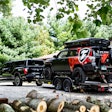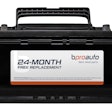 Grant Zimmerman, CEO of Amp Renew.
Grant Zimmerman, CEO of Amp Renew.This is the second part in a two-part interview with Amp Renew CEO Grant Zimmerman. In part 1, Zimmerman talks about the company’s history and why he’s excited about the renewable natural gas (RNG) market. In part 2, he discusses market response to RNG, competition in the growing alternative fuel industry, RNG incentives and biodigester ownership. The entire interview took place recently at ACT Expo in Long Beach, Calif.
HWT: How has the market response been to Amp Renew’s RNG?
Zimmerman: Very positive. We announced deals with two of our customers who are already CNG customers—but deals for them to use renewable gas—and they’re excited about it because they’re customers are excited about it. They’re Ruan and Dillon Transport. We will announce two more deals with very large fleets—we’re just not ready to make it public yet—within the next few weeks. The response has been fast. It’s been extremely positive, and my bottle neck has been getting more sources of renewable gas.
HWT: How’s the RNG market shaping up in California? For instance, there are lot of dairy farms in the state, including some close by to ACT Expo in Ontario, Calif.
Zimmerman: It’s big in California right now. There are several projects in that area as well as Bakersfield where they’re doing more to capture the waste from these dairies. I get multiple calls a week now from food processing all up and down the value chain—landfills, waste water. Everybody is interested in taking this thing that would otherwise be a waste product, whether it’s landfills, ag, or waste water, and turning it into a renewable transportation fuel. Our business is really more after the gas is captured. I don’t think we’ll do another digester, but we will do—we call it GUS, the gas upgrading skid. It’s the machinery that takes the raw gas and cleans it up so that it’s 95-plus percent pure methane and ready for either fueling a vehicle, or you can inject it straight into a natural gas pipeline.

Zimmerman: It’s just not my business model. That’s something that the farms and waste water treatment facilities control. That’s really their asset and so it makes a lot more sense for them to own it. By buying the gas from them they have the opportunity for that investment.
HWT: What makes the RNG market more attractive in California?
Zimmerman: California is good partly because of the low carbon fuel standard that’s here which gives producers and fuelers monetary incentive to use the renewable gases transportation fuel. Federally, the renewable fuel standard—for the same reason that we have ethanol in our gasoline—offers a piece of that legislation that encourages biogas for use as a transportation fuel as well. So, together they take these projects which are more expensive than fossil gas, at least for now and the foreseeable future, and make up some of the economics through incentives so that we can provide the gas at the same cost at our station as we would fossil gas.
HWT: There’s plenty of competition from well-established companies in the alternative fuel business. Do you feel that you’ve got a fair shot in this growing arena?
Zimmerman: We do. I tend not to think of these things in terms of fairness. It’s more, ‘Can we create the value proposition that makes people excited about it and generate that seat at the table?’ I think as CNG has proven itself as a technology, for fueling not only heavy duty trucks but other vehicles as well, it’s become more of a known quantity. You’ve got more experienced fleets. You’ve got UPS announcing that they’re spending a $100 million just a few weeks ago on new CNG stations, new CNG trucks. Frito Lay, a customer of ours, is continuing to invest and grow their fleet and expanding. As CNG takes hold, I think bio-cng or renewable CNG will also get more air time, more space, more gravity with respect to other fuels and renewable fuels.










